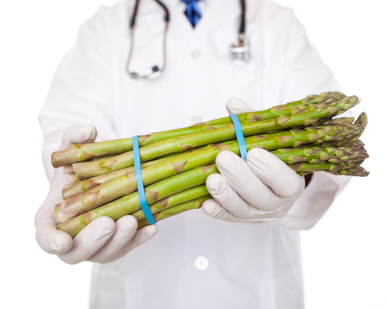
When it comes to the health of the nation, asparagus no expense.
With all the talk of taxing and banning the foods (and sodas) that are bad for us, it’s easy to lose sight of the fact that doing the opposite can work, too. In fact, subsidies for healthy foods can be very effective at changing eating habits. And we’re learning even more about how well this approach can work from an innovative program designed by the nonprofit Wholesome Wave called Fruit and Vegetable Rx.
As the name might suggest, the program provides low-income people who don’t have much access to healthy food a doctor’s “prescription” plus vouchers that can be used to buy fresh fruit and vegetables. Jane Black reports for the Washington Post on Washington, D.C.’s pilot project version of the program run by local nonprofits in conjunction with a health clinic:
On June 6, the clinic began writing “fruit and vegetable prescriptions” to help cover the cost of fresh produce. Thirty-five families will receive vouchers for $1 per family member per day — $112 every four weeks for a family of four — to spend at any of five District farmers markets … The hope is that a medical endorsement of healthful eating, plus cash to buy ingredients, will help families make real changes to the way they shop and eat.
Early data suggests that such programs do exactly that. There’s also anecdotal evidence that these kinds of programs can lead to healthier lifestyles overall:
Michael Lambke implemented the program in the poor, rural community of Skowhegan, Maine. In 2011, 76 percent of patient families attended sessions at the clinic at least three times and made 10 trips to the farmers market, spending more than $5,000 on fresh produce.
Anecdotally, the program is inspiring families to embrace other aspects of a healthful lifestyle, Lambke says. One family got friends to join the program. Another tried out a new walking trail. “The best quote was a kid who came back to me and said that the thing he liked about the program was that his parents played with him more,” Lambke says. “Oh, man. That was awesome.”
Wholesome Wave, which is known mostly for its Double Value Coupon Program for farmers markets, also limits the prescription vouchers to farmers markets. The organization makes a strong economical argument for that emphasis — helping farmers directly provides a great benefit to regions’ local economies while spending money at a supermarket doesn’t.
I would argue that there is also an important nutritional argument for such a restriction. The fact is that most supermarkets are designed to get consumers to buy processed and/or calorie-dense foods. And while it’s true that most farmers markets have sweets for sale, the market’s overall environment contributes to a sense of being surrounded by fresh, healthy food (rather than pushing it to the literal margins).
This question of how the shopping experience contributes to obesity is the subject of a new study by University of Washington researcher Adam Drewnowski. His team found that the vast majority of Seattle residents they studied shopped not at the closest supermarket but at the cheapest one — and their diets often suffered for it. Those who shopped at lower-priced supermarkets had higher rates of obesity than those who shopped at more expensive markets. And this was the case even after controlling for education and income.
The point is that your shopping choice can affect your health — so keeping the low-income participants in these programs at farmers markets and out of supermarkets may enhance the positive effects. They don’t walk in with their coupon for fruits and veggies and walk out with a shopping bag full of soda, salty snacks, and processed foods.
So that’s the good news. The bad news is that more evidence is rolling in that changing diet and physical activity levels probably won’t on their own be enough to address the prevalence of obesity and diet-related diseases like diabetes. Chemicals in our environment are likely a major — if not the major — contributing factor to obesity.
A study by researchers at the University of Chicago, for example, found that a fungicide in common use in Europe (not so much here) can on its own induce insulin resistance (the beginnings of diabetes) in rats — and the researchers believe many chemicals may act in the same way. Another study by a team of scientists in South Korea found that obese children had higher levels of phthalates (a plastic additive found in toys, pacifiers, and many beauty products) in their blood than children of average weight. In fact, the higher the phthalate levels, the more obese the children were.
Some researchers are suggesting that the obesity epidemic itself was kicked off when the pervasiveness of these kinds of chemicals reached a tipping point. (If you’re wondering why there’s a spate of research on this subject, it’s because the annual meeting of the Endocrine Society is going on as we speak.)
Of course, we shouldn’t minimize the value of the kinds of nutrition programs that Wholesome Wave is designing. It’s nothing but good news that they actually seem to work. But it’s also long past time for nutritionists and medical doctors to get behind the idea that futzing with the “calories in/calories out” equation is a necessary, but insufficient, approach to address obesity. Until we have the entire public health community speaking out as forcefully against phthalates and other endocrine disruptors as they do against soda and trans fats, it’s unlikely we’ll ever truly “solve” obesity.



